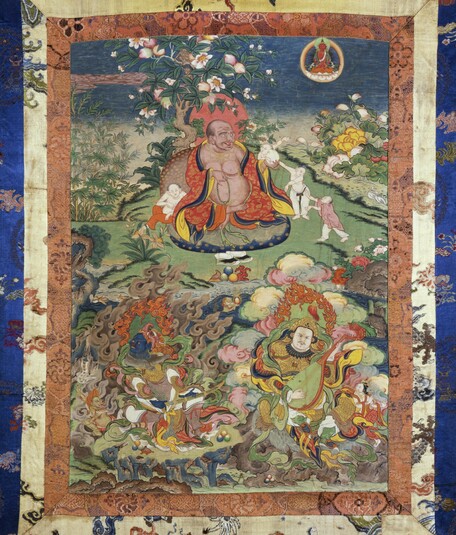
Item: Arhat/Sthavira (Buddhist Elder) - (Patron) Hvashang
| Origin Location | Tibet |
|---|---|
| Date Range | 1800 - 1899 |
| Lineages | Gelug and Buddhist |
| Size | 60.33x43.18cm (23.75x17in) |
| Material | Ground Mineral Pigment on Cotton |
| Collection | Asian Art Museum of San Francisco |
| Catalogue # | B62D44 |
Classification: Person
Appearance: Arhat
Gender: Male
Hvashang (Tibetan: chen tren drup thob hva chang, English: the Greatly Accomplished Supplicant, Hvashang), the Chinese Patron to the Sixteen Great Arhats, along with two of the four Direction Kings, Virupaksha and Virudhaka.

Older in appearance, healthy and rotund, with a receding hairline, he has a mustache and small goatee. The right hand holds to the heart a mala, string of prayer beads. The left held upraised offers a persimmon fruit. Adorned with gold earrings and wrapped with an upper cloak of red and blue brocade, he wears a lower garment of orange, seated in a relaxed posture atop a deerskin mat. The head is encircled by a pink aureole, and a tree with a canopy of leaves and blossoms provides shelter above. Four small children fair in complexion, energetic and robust, play at the side. A fifth sleeps behind.
At the upper right on turbulent waters, a teacher is seated in a boat greeted by a crowd of monks. At the left, against a mountain landscape and cascading waterfall, above a pond, two Garuda birds swoop down towards two naga figures, (symbolizing environmental balance).
At the lower left side is Dhritarashtra, Guardian of the Eastern Direction and King of the Gandharva - celestial musicians. He holds a lute in the two hands.
At the left side is Virudhaka, King of the South, dark blue in colour. He holds a sword in the right hand clutched to the side. In a standing posture he is surrounded by brown smoke and a green aureola encircling the head. At the left side is a wrathful green attendant holding a spear.
Hvashang, meaning a 'Chinese monk,' was allegedly an historic figure dispatched to India by a Tang Emperor to invite the buddha Shakyamuni to visit China. Since the Buddha had already passed away the invitation was then relayed to the 16 great arhats. Regarded as a monk he is also referred to as a patron because he presented the invitation. Neither of the common liturgies to the meditation practice of Shakyamuni Buddha and the 16 Arhats, popularized by the Lord Atisha and Kashmiri Pandit Shakya Sribhadra, make reference to Hvashang. Therefore it is likely that he is an iconographic concept imported from China at a later time.
Hvashang and the Direction Kings belong to a thematic set of paintings known as 'Shakyamuni Buddha and the Sixteen Great Arhats.' The full group comprises twenty-five figures: the buddha Shakyamuni, together with the two foremost disciples - Shariputra and Maudgalyayana, the Sixteen Arhats, the attendant Dharmata, the patron Hvashang and the Four Guardians of the Directions; Vaishravana, Virupaksha, Dritarashtra and Virudhaka.
Jeff Watt 6-99 [Updated 5-2009]
Collection of Asian Art Museum of San Francisco
Arhat: Hvashang (Patron) Main Page
Painting Set: Arhat Set: Asian Art Museum (SF)
Arhat: Hvashang (Patron) Block Prints
Arhat/Sthavira: Block Print Sets (Nartang)
